1. Introduction
Haicom recently announced a BT GPS device equipped with the SiRF III chipset with however, an interesting addition, that of a digital compass. Haicom kindly offered us the chance to test the new 406 BT-C model. Having already tested another BT GPS device from Globalsat, a direct comparison would be interesting for many potential buyers. First, let's see some background information about Haicom.
- Haicom background
 is a manufacturer and exporter of GPS receivers, PDA accessories and a line of multimedia products. Established in 1990, the company has grown to employ 30 people and sees a yearly sales figure of US$8 million. The cornerstone to Haicom's success is the commitment to quality control. Also a major concern to comply is customer services. To the company, quality control and customer service make a win in combination. Yearly sales affirm this philosophy.
is a manufacturer and exporter of GPS receivers, PDA accessories and a line of multimedia products. Established in 1990, the company has grown to employ 30 people and sees a yearly sales figure of US$8 million. The cornerstone to Haicom's success is the commitment to quality control. Also a major concern to comply is customer services. To the company, quality control and customer service make a win in combination. Yearly sales affirm this philosophy.
Haicom is an international supplier with markets around the world. Presently, the sales split is 60% in Europe, 30% in North America and 10% elsewhere. Expansion of any current markets is encouraged as well as entrance into new markets. With their full line of products, Haicom strongly encourages OEM and ODM customers to contact them at their office in Taiwan.
- Haicom 406BT-C
 The HI-406BT-C is a GPS (Global Positioning System)
receiver boasting a wireless Bluetooth interface with built-in
active antenna and extra digital compass
functions. With the HI-406BT-C, your mobile devices,
such as Smartphone, PocketPC, laptopPC, tabletPC,
etc. can receive GPS data wirelessly and perform
GPS functions such as car navigation,
personal navigation, route planning, tracking, etc.
The HI-406BT-C is a GPS (Global Positioning System)
receiver boasting a wireless Bluetooth interface with built-in
active antenna and extra digital compass
functions. With the HI-406BT-C, your mobile devices,
such as Smartphone, PocketPC, laptopPC, tabletPC,
etc. can receive GPS data wirelessly and perform
GPS functions such as car navigation,
personal navigation, route planning, tracking, etc.
 Equipped with the most powerful and ultra high sensitive SiRF StarIII chipset, the HI-406BT-C can obtain a 3D fix in a very short time and under poor reception environment, such as in the middle of the car, next to a tall building, in your backpack or pocket.
Equipped with the most powerful and ultra high sensitive SiRF StarIII chipset, the HI-406BT-C can obtain a 3D fix in a very short time and under poor reception environment, such as in the middle of the car, next to a tall building, in your backpack or pocket.
In case the mobile device runs out of battery, the HI-406BT-C can also work stand alone providing you with directions and using the on board digital compass. As soon as you turn on the digital compass, the 12 LEDs on top of the HI-406BT-C will indicate north and south headings on the earth's magnetic field by lighting up the direction: the red light indicating north and the green light indicating south.
- Used chipset
The SiRF III chipset has the following specifications:
| Chipset: |
SiRF Star III WAAS enabled |
| Frequency: |
1, 1575.42 MHz |
| C/A code: |
1.023 MHz chip rate |
| Channels: |
20 channel all-in-view tracking |
| Position Accuracy: |
10 meters, 2D RMS |
| ~ 5 meters, 3D RMS WAAS |
| Velocity: |
0.1 m/s |
| Time: |
us synchronized to GPS time |
| Default: |
WGS-84 Acquisition Time (Open sky, stationary) |
| Reacquisition: |
0.1 sec., average |
| Hot start: |
1 sec., average |
| Warm start: |
38 sec., average |
| Cold start: |
42 sec., average |
| Altitude: |
18,000 meters (60,000 feet) max. |
| Velocity: |
515 meters/second (1000 knots) max. |
| Acceleration: |
Less than 4g |
| Jerk: |
20 m/sec |
| Protocol messages: |
NMEA-0183 output protocol |
| Output format: |
GGA(1sec), GSA(5sec), GSV(5sec), RMC(1sec),VTG(1sec) |
| Operating temperature: |
-20° to 60° C |
| Humidity: |
5% to 95% Non-condensing |
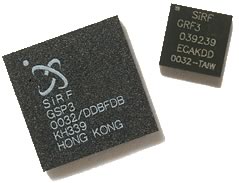
Looking at the SiRF III specs, we can notice that the chipset is capable of receiving up to 20 satellites (actually 12 maximum), has very low Hot/Warm/Cold start times and its accuracy reaches ~5m when the WAAS mode is enabled.
2. Features - Page 1
- 20 Channels "All-In-View" Tracking
- Position accuracy of 10 metres 2D RMS
- Cold/Warm/Hot Start Time: 42/38/1 Seconds (Signal Strength > 30 dB-HZ)
- Re-acquisition Time: 0.1 seconds
- Support Standard NMEA-0183 at 38400 bps baud rate (Defined by customer 4800 up to 57600)
- Support Power Saving Mode
- Compatible with Bluetooth devices with Serial Port Profile (SPP)
- Built-in digital compass with 12 LED indications
- Superior Sensitivity for Urban Canyon and Foliage Environment
- Ultra small, sleek and lightweight design easily fits in your hand
- Li-polymer battery lasts for more than 8 hours of use in connection
For our testing purposes, Haicom sent us the retail package that included:
- the HI-406BT-C GPS receiver itself
- a carrying pouch
- an AC power adaptor with USB female plug
- a cigarette lighter adaptor with USB female plug
- a mini1394 to USB cable
- and finally a CD-ROM with corresponding software and user's Manual
The current price for the product is at around US$105.00, as found on the net.


The contents of the retail package are shown below:

Looking at the device, we can see on the left and right hand sides are two slider switches that enable the digital compass/BT GPS device functions and two LEDs at the top. The external dimensions of the BT-338 are 64.8mm x 46.4mm x 24mm with a weight of <90gr:




On the bottom side, we can find the charger interface (mini USB) and the external cable jack (MMCX compatible). The package, as we saw earlier, includes two chargers, one for AC/DC and one for car. Since the device is USB compatible, it can be powered from the PC USB port also!



3. Features - Page 2
By using a variety of optional connection cables,
the HI-406BT-C can become all kinds of wired GPS receiver
solutions (optional).

After removing the battery cover, we can see the device's S/N and other information:

The included battery is rated at 3.7V and 1000mAh. According to the specs, the HI-406BT-C can hold out for up to 8 hours with the standard battery. Since the battery is a standard Nokia BL5C compatible, the user could conceivably use a similar battery designed for Nokia phones as a replacement.

Comparing the device with the Globalsat BT-338, we can see that in size they are very similar, with the Haicom device being somewhat smaller but wider:


If you turn on the digital compass using the left slider, the device will power up and the 12 LEDs will show north/south direction: the red light indicating north and the green light indicating south. The digital compass or the Bluetooth GPS receiver
can work independently or simultaneously.
Even if the Bluetooth GPS receiver is switched off,
the compass still works and the HI-406BT-C acts
purely as a digital compass.

If the HI-406BT-C digital compass is functioning
normally, the sensing accuracy may be affected in
the following circumstances:
1. Indication of north/south can be distorted when the device is next to
the ferrous materials, including buildings, bridges,
railroads, etc.
2. It can also be influenced by ferro-magnetic
materials, such as when standing next to a speaker.
The HI-406BT-C digital compass' functionality is designed
for general-purpose and not for special purpose
use, such as aviation, space, traffic
devices or medical applications such as life support systems, or
devices which can affect human life or injure
someone if the device malfunctions.
For special-purpose use, a high level device, specially designed for that purpose needs to be used.
4. Installation
Before using the device, you have to fully charge the batteries. From our tests, it required around 3 hours to fully charge them. To connect the device, you have to use the right slider and follow several simple steps on your PDA device, which in our case was a Dell Axim x50V with Windows Mobile 2003 SE. Start by accessing the Bluetooth manager and tap New->Connect
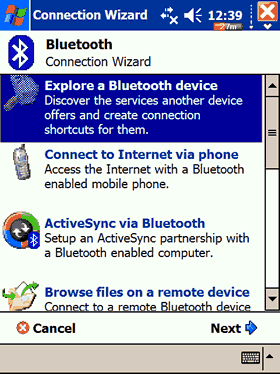
The HI-406BT-C will show up with an ID of HI-406BT:

Press Next->Select GPS OUTPUT-> Next

Done!

After accessing the BT Manager, right click,

and select Connect.

Finally, our device was connected to the Dell Axim x50V PDA and ready for use! There are several details available regarding the activity on the BT port.

The device can be found at COM7 with 4800 communications speed. Press the "Scan GPS" and if all goes well, you will see a lot of numbers scrolling by.
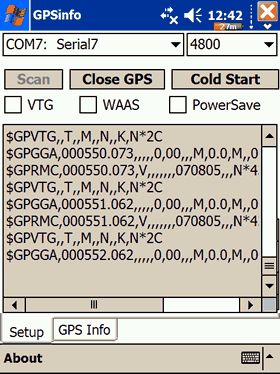
By using the special SiRF mode from GPS Tweak, we confirmed that our device had firmware version 3.1.1 installed:
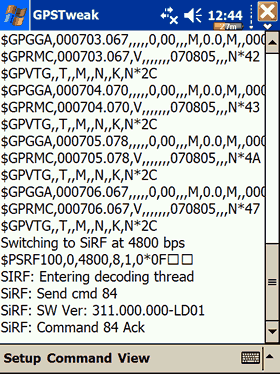
Haicom offers a software that can be used to monitor the device's main features, but also perform a firmware upgrade, in case it's needed:
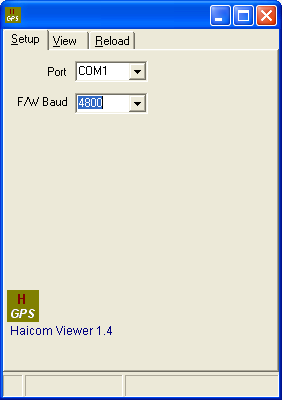


5. The Tests
- Tests Day One
We tested the Haicom 406BT-C with the Dell Axim X50v. We recorded all produced data for a pre-selected route with VisualGPSce (free edition) and later analyzed it with GPSLog. In order to measure the TTFF ("Time to First Fix" which is the time it takes for a GPS to determine its current position), we used GPSInfo "Cold Start" function. All tests ran continuously, under the same environmental conditions (night, clear sky, 15° C ) and installed in an Audi A4, 2004.
|
Globalsat BT-338 |
Haicom HI-406BT-C |
|
Time to First Fix (TTFF) |
Secs |
36.66 sec |
33.66 sec |
|
Fix |
Invalid |
0 |
0 |
|
2D |
0 |
0 |
|
3D |
100
|
100 |
|
Satellites |
Average (in view) |
8 |
11.01 |
|
Average (in use) |
5.90 |
6.79 |
|
Average Signal Level (in dB) |
Maximum per Satellite |
46.67 |
46.29 |
|
Average per Satellite |
38.93 |
36.56 |
The Globalsat BT-338 had slightly better performance than the HI-406BT-C in terms of Average Signal Level (max/average) per satellite. On the other hand, the HI-406BT-C can "view" and "use" more satellites than the BT-338. The TTFF times are very close, under 45 secs, which is very good. The reported altitudes are very different however...
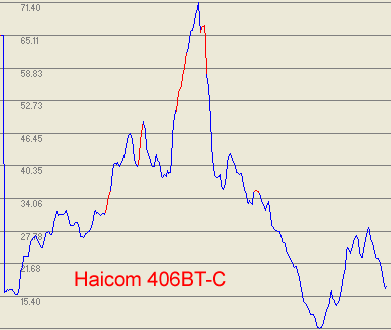

- Tests Day Two
Again we used our Dell Axim X50v, VisualGPSce, GPSLog and GPSInfo. All tests ran continuously, with the same environmental conditions (day, cloudy weather, 4° C) installed in an Audi A4, 2004. This time we also used an external antenna to see if there would be any difference.
|
Haicom 406BT-C |
Haicom 406BT-C + antenna |
|
Time to First Fix (TTFF) |
Secs |
33.66 sec |
32.15 sec |
|
Fix |
Invalid |
0 |
0 |
|
2D |
0 |
0 |
|
3D |
100
|
100 |
|
Satellites |
Average (in view) |
9.11 |
9.77 |
|
Average (in use) |
5.95 |
5.86 |
|
Average Signal Level (in dB) |
Maximum per Satellite |
43.67 |
45.17 |
|
Average per Satellite |
35.51 |
37.88 |
Using an external antenna seemed to improve the performance of the 406BT-C since it returned lower TTFF times, more satellites "in view" and higher Average Signal Levels (max/average) per satellite, compared with the antenna-less results.
6. Conclusion
 The Haicom 406BT-C is an interesting product, combining the power of the SiRF III chipset as well as a digital compass. The retail package is complete and the device has many connection options (external antenna, GPS mouse). It also uses a Nokia compatible battery pack which is very convenient. Performance was very similar to the Globalsat BT-338, another GPS device also driven by the SiRF III chipset.
The Haicom 406BT-C is an interesting product, combining the power of the SiRF III chipset as well as a digital compass. The retail package is complete and the device has many connection options (external antenna, GPS mouse). It also uses a Nokia compatible battery pack which is very convenient. Performance was very similar to the Globalsat BT-338, another GPS device also driven by the SiRF III chipset.
Comparing the HI-406BT-C with the BT-338, its most obvious weakness is the lower battery capacity (1000mAh vs. 1700mAh) and the lack of any power management (auto, on/off). The HI-406BT-C is cheaper than the BT-338 (US$105 and US$120 respectively), which may be a deciding factor when choosing which device to buy. Both devices are very good performers and will serve you reliably on your next trip.
The Positive
- SiRF III chipset with latest firmware (3.1.1)
- Combo (GPS BT and Digital compass) device
- Complete retail package
- Car charger is included
- Very good performance
- Easy installation (includes a nicely printed manual)
- External antenna can be connected (optional cable)
- Can be used with GPS mouse (optional cable)
- Included battery is Nokia compatible
- Firmware can be updated through Haicom Viewer
- Small and light weight make it very portable
The Negative
- Doesn't support automatic power on/off mode
- No markings on sliders, which is for BT or Digital Compass functions
- Included battery lasts only 8 hours (according to the specs)